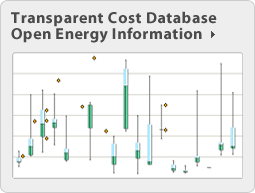Simple Levelized Cost of Energy (LCOE) Calculator Documentation
This is a simple LCOE calculator to give a metric that allows the comparison of the combination of capital costs, O&M, performance and fuel costs. Note that this doesn't include financing issues, discount issues, future replacement or degradation costs, etc. which would need to be included for a more complex analysis.
Financial Assumptions
Adjust the sliders to suitable values for book life in years and discount rate. The discount rate may be nominal or real. Using periods and discount rate we calculate a capital recovery factor (CRF). A capital recovery factor is the ratio of a constant annuity to the present value of receiving that annuity for a given length of time.
Using an interest rate i, the capital recovery factor is:
CRF = {i(1 + i)^n} / {[(1 + i)^n]-1}
where n is the number of annuities received. This is related to the annuity formula, which gives the present value in terms of the annuity, the interest rate, and the number of annuities. If n = 1, the CRF reduces to 1 + i. As n goes to infinity, the CRF goes to i (Source: 1).
Cost and Performance
Adjust the sliders to suitable values for each of the cost and performance values.
Simple Levelized Cost of Energy Calculation
The simple levelized cost of energy is calculated using the following formula:
sLCOE = {(overnight capital cost * capital recovery factor + fixed O&M cost )/(8760 * capacity factor)} + (fuel cost * heat rate) + variable O&M cost.
Where overnight capital cost is measured in dollars per installed kilowatt ($/kW), capital recovery factor is a fraction calculated as described above. Fixed Operation and Maintenance (O&M) costs in dollars per kilowatt-year ($/kW-yr) and variable O&M costs in dollars per kilowatt-hour ($/kWh).
In the denominator 8760 is the number of hours in a year and capacity factor is a fraction between 0 and 1 representing the portion of a year that the power plant is generating power.
Fuel cost is expressed in dollars per million British thermal units ($/MMBtu) and heat rate is measured in British thermal units per kilowatt-hour (Btu/kWh). Fuel cost is optional since some generating technologies like solar and wind do not have fuel costs.
Levelized Cost of Energy (LCOE, also called Levelized Energy Cost or LEC) is a cost of generating energy (usually electricity) for a particular system. It is an economic assessment of the cost of the energy-generating system including all the costs over its lifetime: initial investment, operations and maintenance, cost of fuel, cost of capital. A net present value calculation is performed and solved in such a way that for the value of the LCOE chosen, the project's net present value becomes zero (Source: 2, 3).
This means that the LCOE is the minimum price at which energy must be sold for an energy project to break even.
Typically LCOEs are calculated over 20 to 40 year lifetimes, and are given in the units of currency per kilowatt-hour, for example USD/kWh or EUR/kWh or per megawatt-hour.
When comparing LCOEs for alternative systems, it is important to define the boundaries of the 'system' and the costs that are included in it. For example, should transmissions lines and distribution systems be included in the cost? Should R&D, tax, and environmental impact studies be included? Should the costs of impacts on public health and environmental damage be included? Should the costs of government subsidies be included in the calculated LCOE?
Another key issue is the decision about the value of the discount rate i. The value that is chosen for i can often 'weight' the decision towards one option or another, so the basis for choosing the discount must clearly be carefully evaluated. The discount rate depends on the cost of capital, including the balance between debt-financing and equity-financing, and an assessment of the financial risk.
Sources
Capital recovery factor, Wikipedia (Accessed June 3, 2010)
Levelised energy cost, Wikipedia (Accessed June 3, 2010)
A Manual for the Economic Evaluation of Energy Efficiency and Renewable Energy Technologies, NLR Technical Report (1995)
Share
Last Updated Dec. 6, 2025

